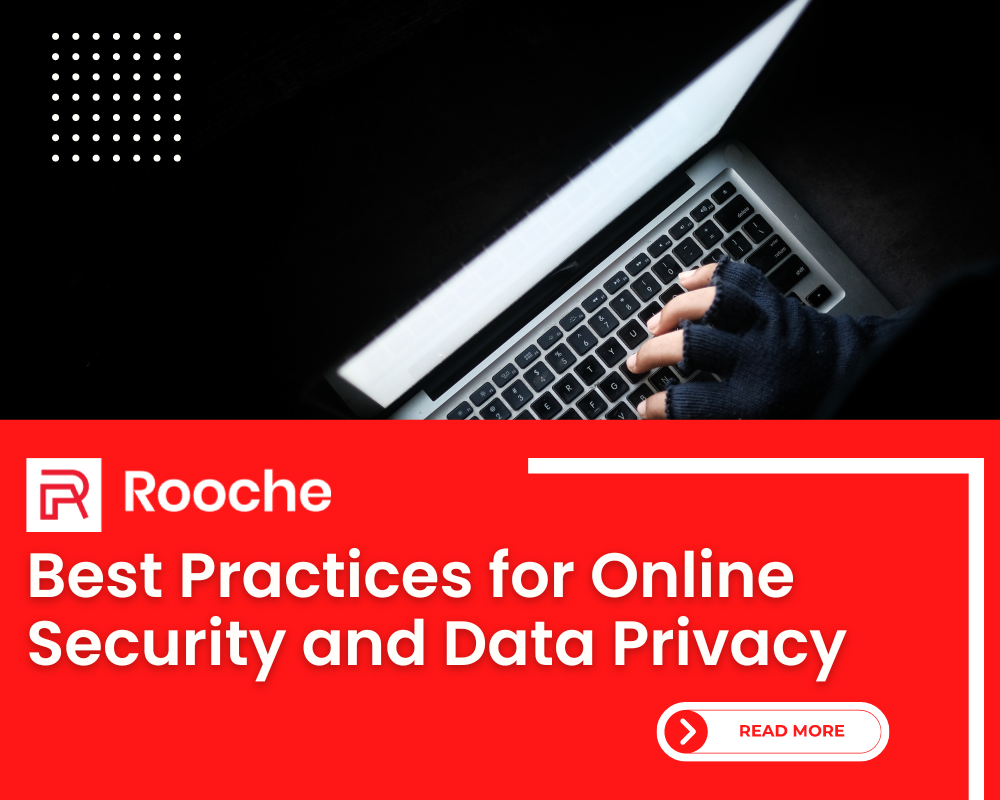What’s A Responsive Web Design & Why Should You Care?
Each year, a new set of web design trends emerge as designers across the globe attempt to push the boundaries […]
Dec 8, 2022
Aug 25, 2023

Our lives are intertwined with the online world, ensuring robust online security and safeguarding our data privacy has become more critical than ever before. With cyber threats and data breaches on the rise, it’s imperative to adopt best practices that not only protect our personal and sensitive information but also grant us peace of mind as we navigate the virtual landscape. In this article, we will explore the top strategies and habits to maintain a secure online presence without compromising our data privacy.
Keeping your software updated is of utmost importance in maintaining the security, functionality, and performance of your digital systems. Whether you’re running operating systems, applications, or plugins, regular updates ensure that you have access to the latest features, bug fixes, and security patches.
Outdated software can become vulnerable to cyberattacks and security breaches. Hackers often exploit known vulnerabilities in older versions of software to gain unauthorized access to your systems. By regularly updating your software, you can effectively mitigate these risks and protect sensitive data from potential threats.

Moreover, updates often introduce improvements and optimizations that enhance the user experience. New features and functionalities can streamline your workflow and boost productivity. Staying up-to-date also ensures compatibility with the latest file formats, web standards, and third-party integrations, which is particularly important for maintaining seamless communication and collaboration.
To facilitate the update process, many software applications provide automated update mechanisms. However, it’s also essential to periodically check for updates manually, especially for critical systems and security-related software. By doing so, you demonstrate a proactive approach to digital hygiene and safeguard the integrity of your digital infrastructure.
In conclusion, keeping your software updated is a fundamental practice that directly impacts security, performance, and usability. Regular updates not only shield your systems from potential threats but also ensure you’re making the most of the latest features and improvements available in the software landscape.
Using strong and unique passwords is paramount for safeguarding your online accounts and sensitive information. A strong password is one that combines a mix of uppercase and lowercase letters, numbers, and special characters. Creating unique passwords for each of your accounts ensures that a security breach on one platform won’t compromise your other accounts.
The importance of strong passwords lies in their ability to thwart common hacking methods like brute force attacks, where hackers systematically guess combinations until they find the correct one. A strong password significantly reduces the likelihood of unauthorized access to your accounts.

Avoid using easily guessable information such as birthdays, names, or common words. Instead, opt for a passphrase or a random sequence of characters that has no personal connection. Length also matters – the longer the password, the harder it is to crack.
Managing numerous passwords might seem daunting, but using a reputable password manager can simplify this task. Password managers generate, store, and auto-fill strong and unique passwords for all your accounts, enhancing both security and convenience.
Remember that even the strongest password is vulnerable if shared or stored improperly. Never share your passwords with anyone, and avoid writing them down in easily accessible places. Regularly update your passwords, especially if you suspect any unauthorized activity.
In essence, strong and unique passwords are your first line of defense against cyber threats. By investing the effort to create and manage them, you significantly enhance the security of your digital identity and sensitive data.
Multi-Factor Authentication (MFA) is a robust security measure that adds an extra layer of protection to your online accounts. It requires users to provide multiple forms of verification before granting access, enhancing security beyond just a password. MFA mitigates the risks associated with stolen passwords or unauthorized access, making it a crucial component of modern cybersecurity strategies.
The primary factor in MFA is usually something you know – like a password or PIN. The second factor, or sometimes even more factors, are typically something you have, like a smartphone or security token, or something you are, like a fingerprint or facial recognition. By combining these factors, MFA ensures that even if one factor is compromised, an attacker still needs the other factor(s) to gain access.

Implementing MFA reinforces the protection of your accounts because it becomes significantly more difficult for unauthorized individuals to impersonate you. Even if they somehow acquire your password, they would still need physical possession of your second-factor device or biometric information to successfully breach your account.
Many online services, including email platforms, social media, banking, and productivity tools, offer MFA as an option. It’s highly recommended to enable MFA wherever possible, especially for critical accounts that contain sensitive information or provide access to valuable resources.
While MFA provides a substantial security boost, it’s important to manage your MFA methods responsibly. Keep backup options or codes in case you lose your primary device, and regularly review and update your MFA settings as needed.
Using encrypted connections, specifically SSL (Secure Sockets Layer) or its successor TLS (Transport Layer Security), is essential for maintaining the confidentiality and integrity of data transmitted over the internet. SSL/TLS protocols establish secure communication channels between a user’s device and a website’s server, ensuring that data remains private and protected from interception by malicious actors.
When you visit a website that employs SSL/TLS, you’ll notice that the URL starts with “https” instead of just “http.” The ‘s’ stands for ‘secure,’ indicating that the connection is encrypted. This encryption is particularly crucial when you’re sharing sensitive information, such as login credentials, credit card details, or personal data.
SSL/TLS works by encrypting the data exchanged between your device and the server, making it unreadable to anyone who might attempt to intercept it. This encryption extends across various stages of data transmission, including when you submit forms, browse pages, or conduct online transactions. It helps prevent data breaches, man-in-the-middle attacks, and other types of cyber threats.
Website owners can obtain SSL/TLS certificates from trusted Certificate Authorities (CAs) to enable encrypted connections. These certificates also serve as an assurance to visitors that the website they’re interacting with is authentic and secure.
Web browsers often display visual cues, like a padlock icon or a green address bar, to indicate that a website is using SSL/TLS encryption. Conversely, websites lacking these indicators might be flagged as potentially insecure by browsers.
Regularly monitoring your accounts is a fundamental practice to ensure the security of your digital presence and quickly detect any suspicious or unauthorized activities. Whether it’s your financial accounts, email, social media, or other online platforms, staying vigilant helps you maintain control over your information and respond promptly to potential threats.
Frequent monitoring involves regularly reviewing your account statements, transaction history, and login activities. Look for any transactions or access attempts that you don’t recognize. If you notice anything unusual, take immediate action by reporting it to the relevant service provider and changing your credentials.
For financial accounts, set up alerts for any large or unexpected transactions. Many banks and financial institutions offer notification services that can alert you via email, text, or app notifications whenever certain activities occur on your accounts.
Regularly reviewing your email account for unfamiliar emails, especially those requesting personal information or account details, can help you avoid falling victim to phishing attacks. Cybercriminals often use deceptive emails to trick users into revealing sensitive information.
It’s also a good practice to periodically review and update your security settings, such as passwords and recovery information. Removing unused accounts and apps that have access to your data can also minimize your exposure to potential breaches.
In a digital landscape fraught with cyber threats, implementing best practices for online security and data privacy is paramount. By staying vigilant, practicing good habits, and being aware of potential risks, individuals can enjoy a safer online experience.

Each year, a new set of web design trends emerge as designers across the globe attempt to push the boundaries […]
Dec 8, 2022

Mobile app has been a game changer in the health and fitness industry. It has made it easier for people […]
Dec 8, 2022

Having a website is one of the most important things a business can do. In fact, there is no such […]
Dec 8, 2022
Join our newsletter and be the first to receive future promo and sale updates from Rooche!